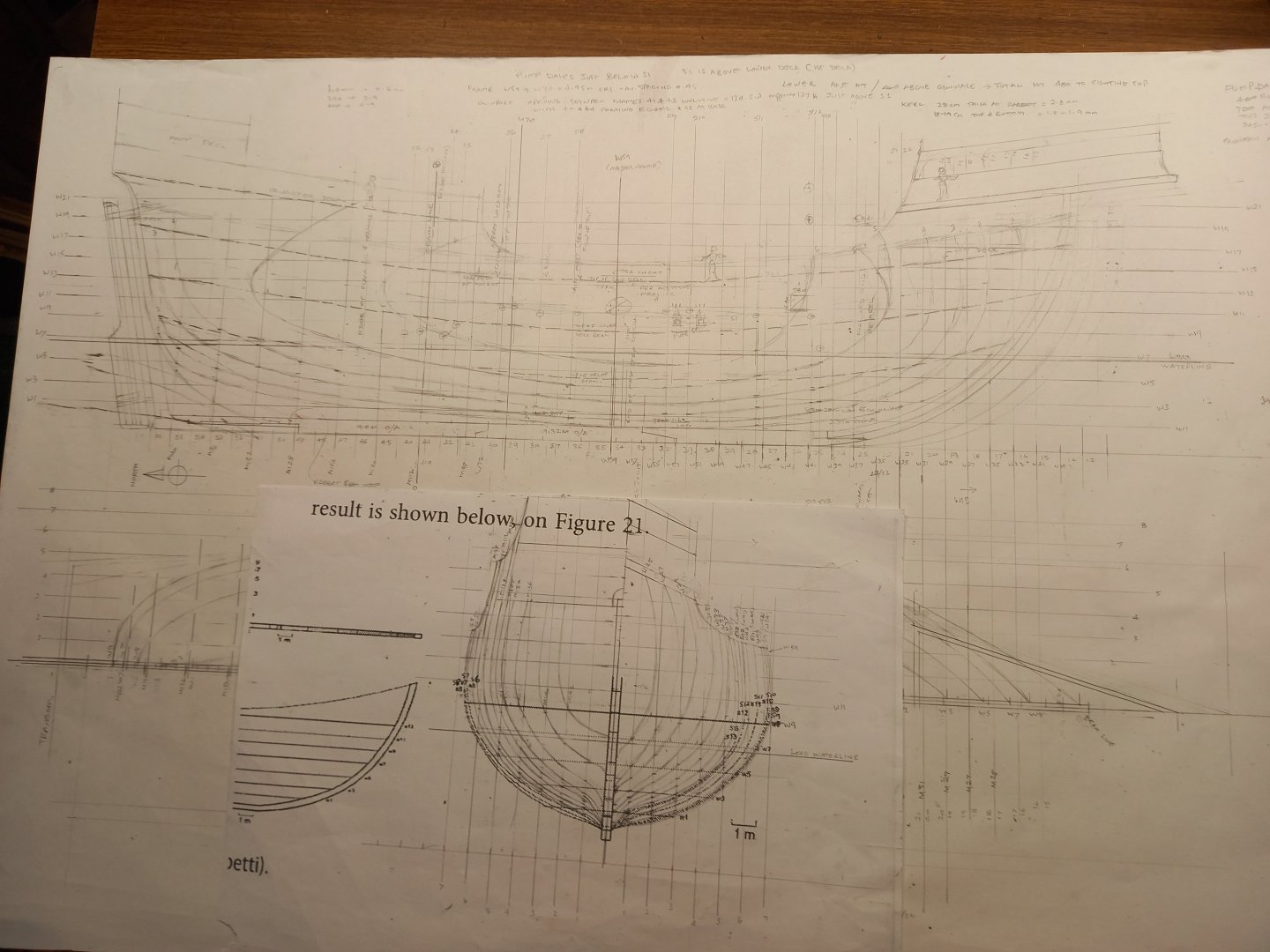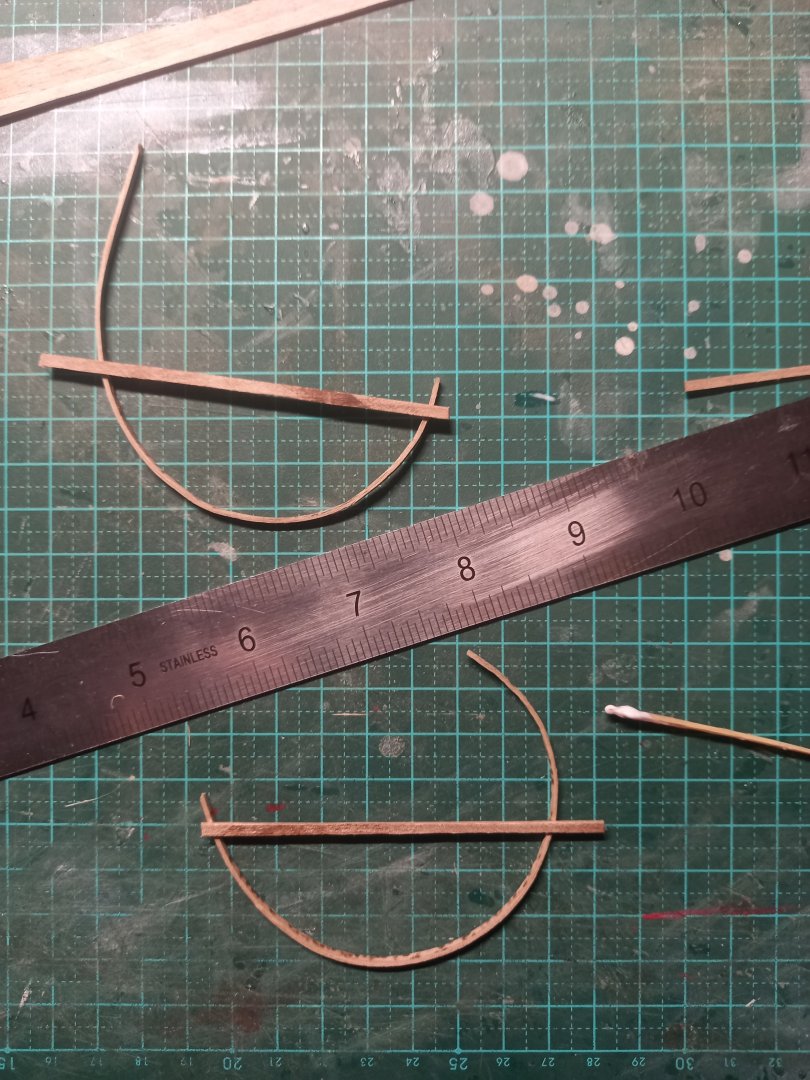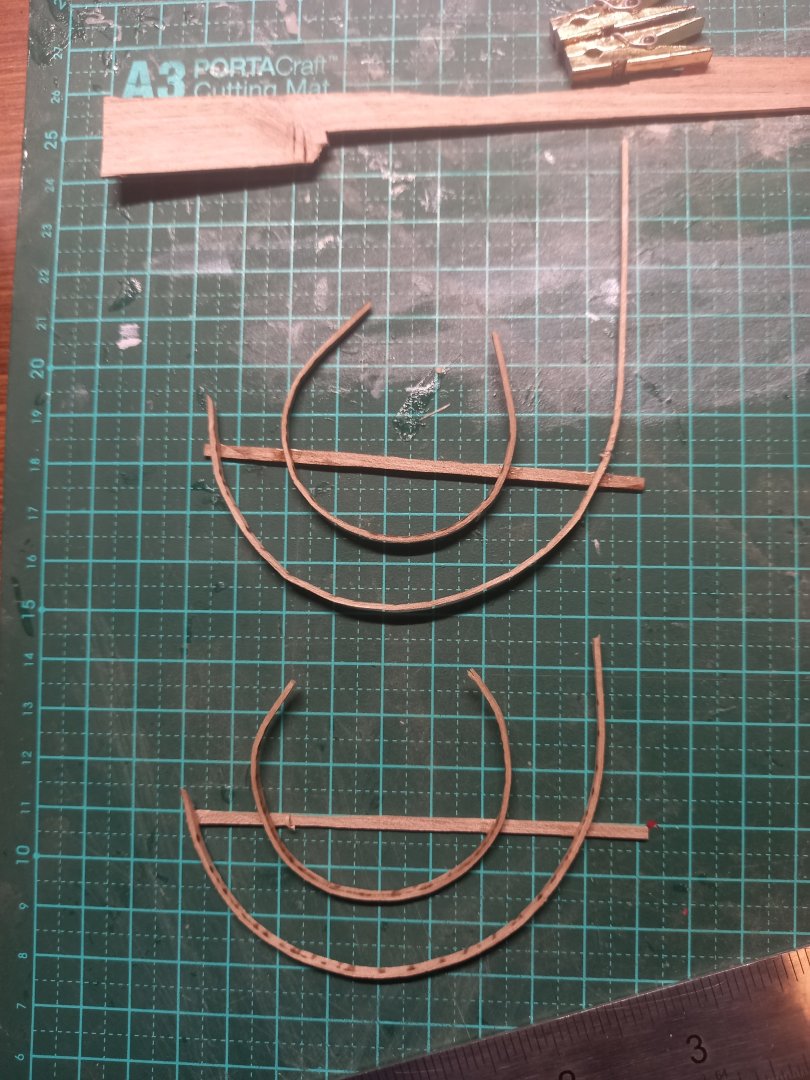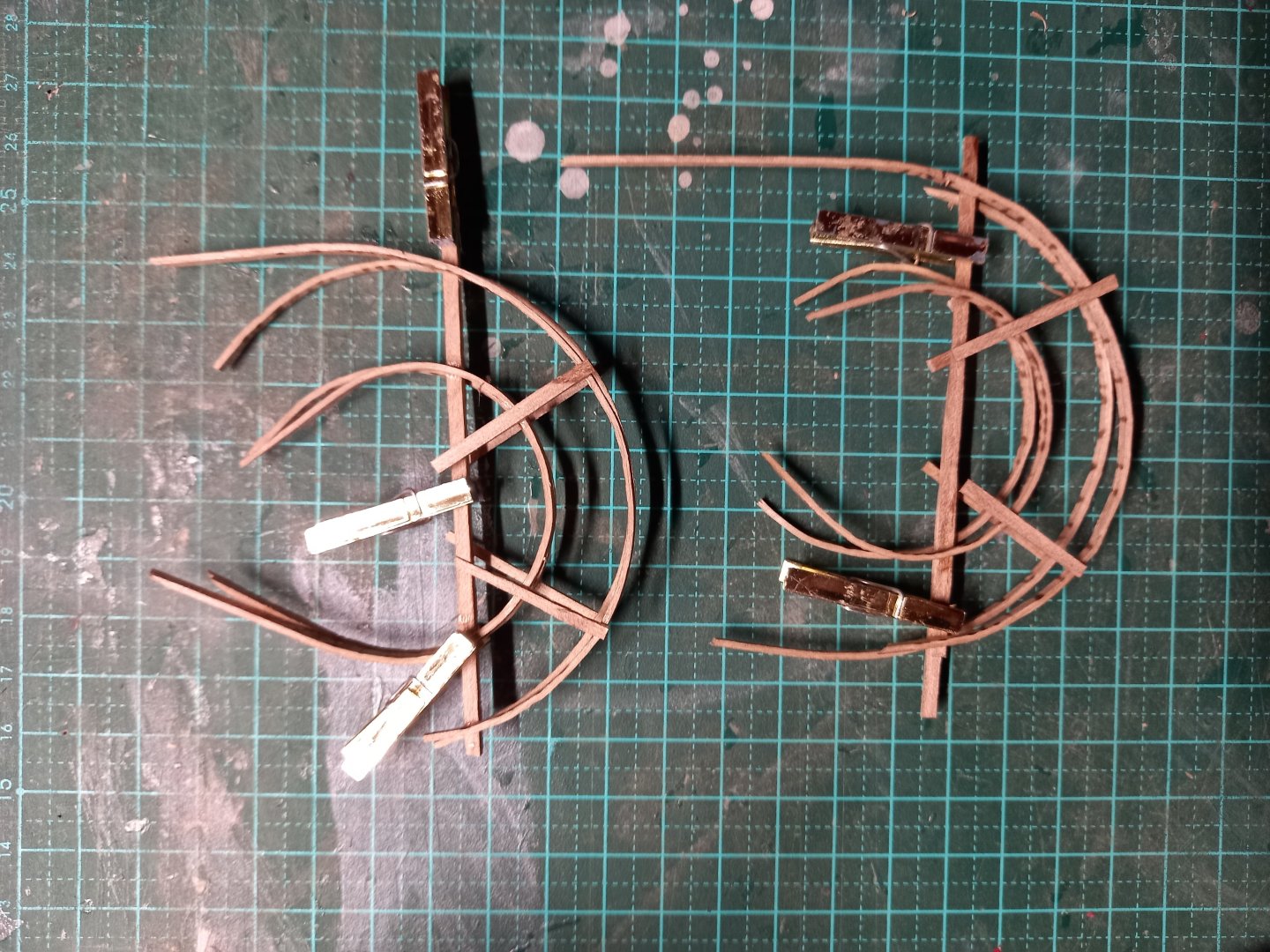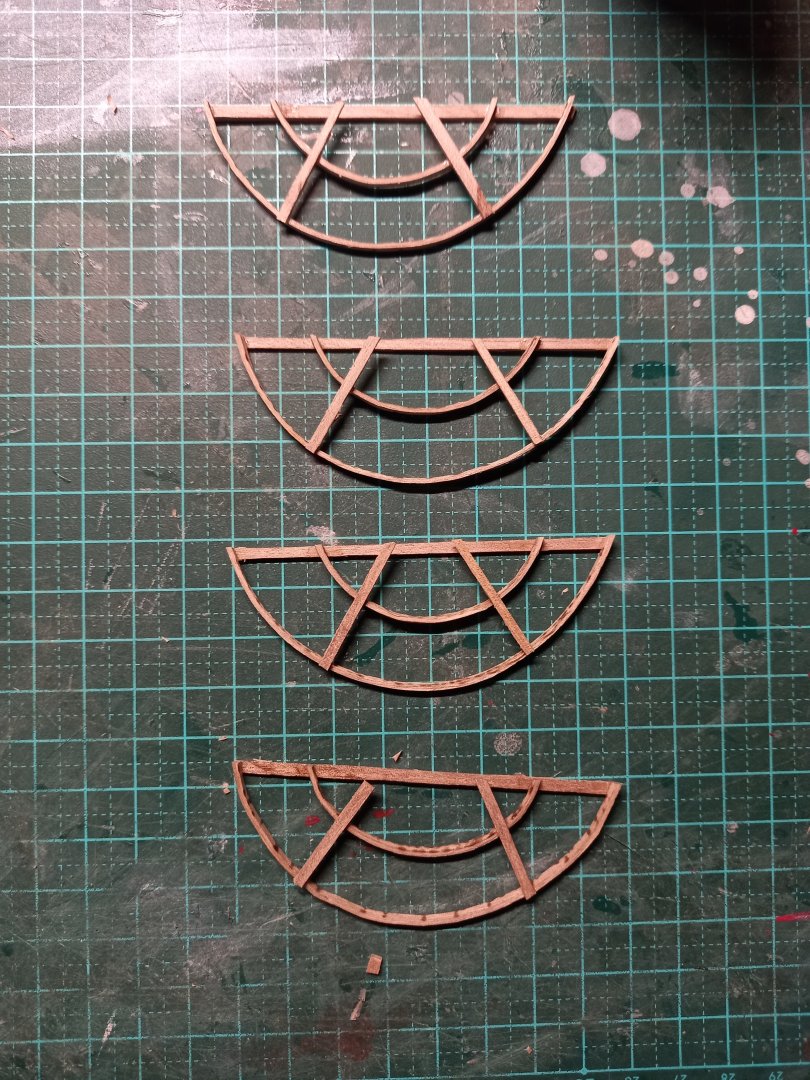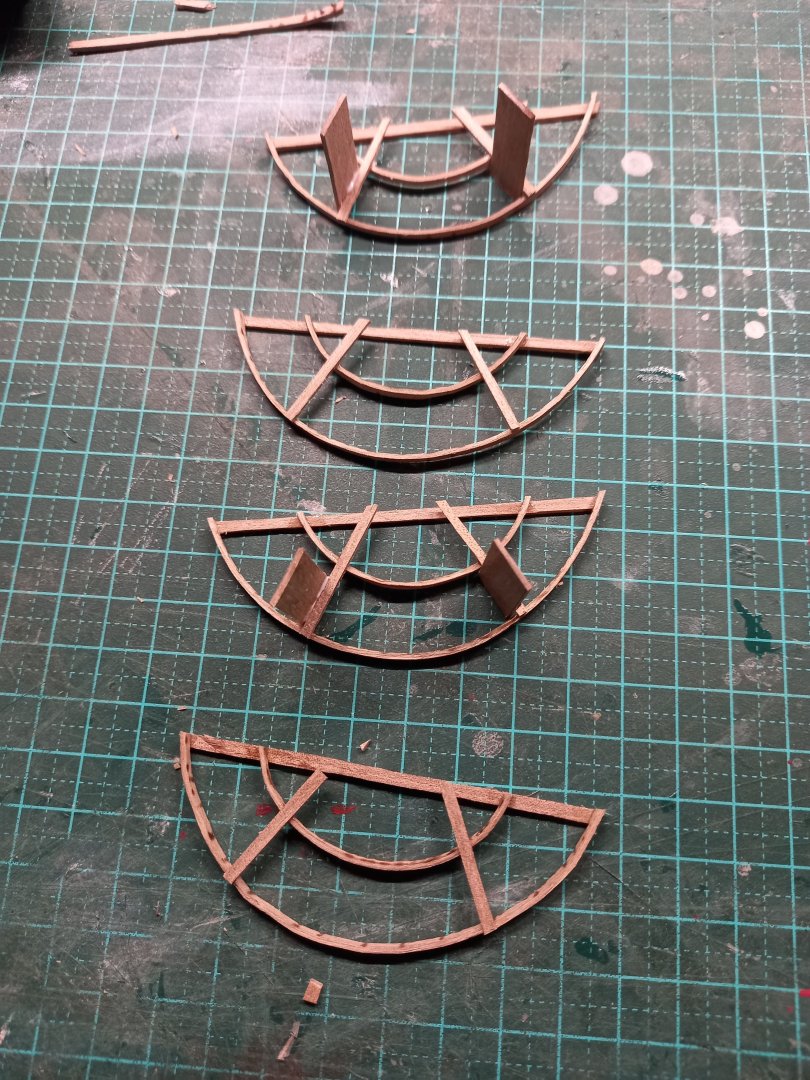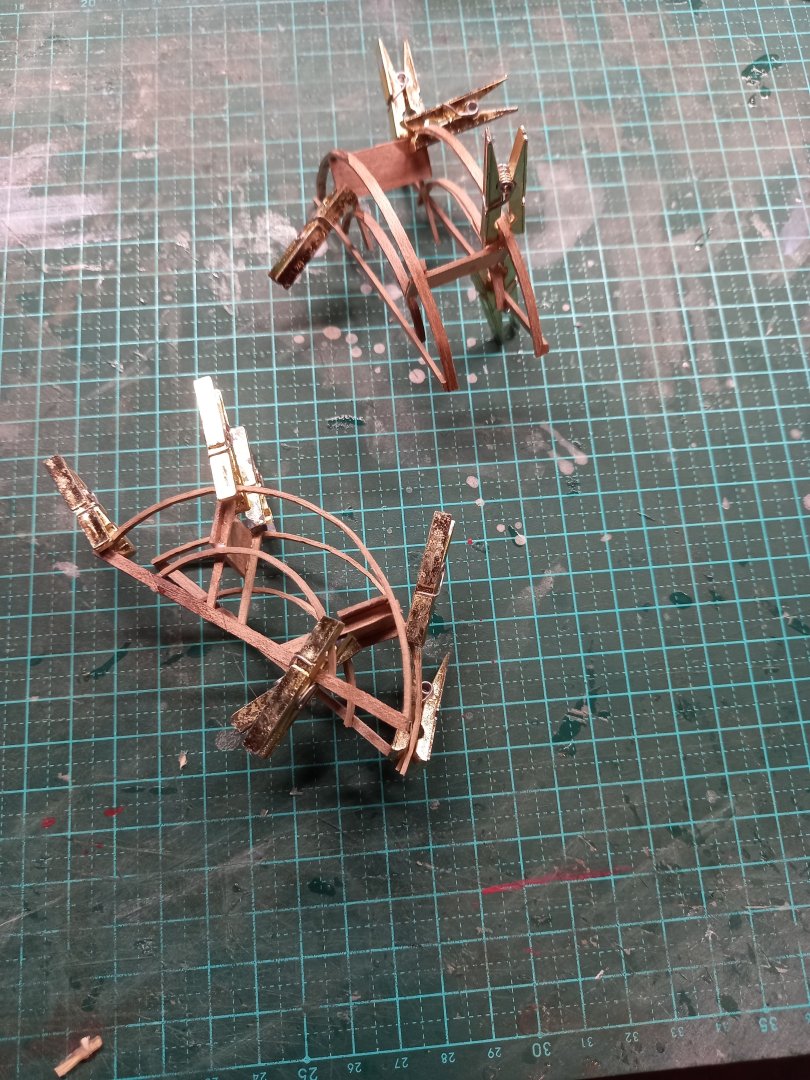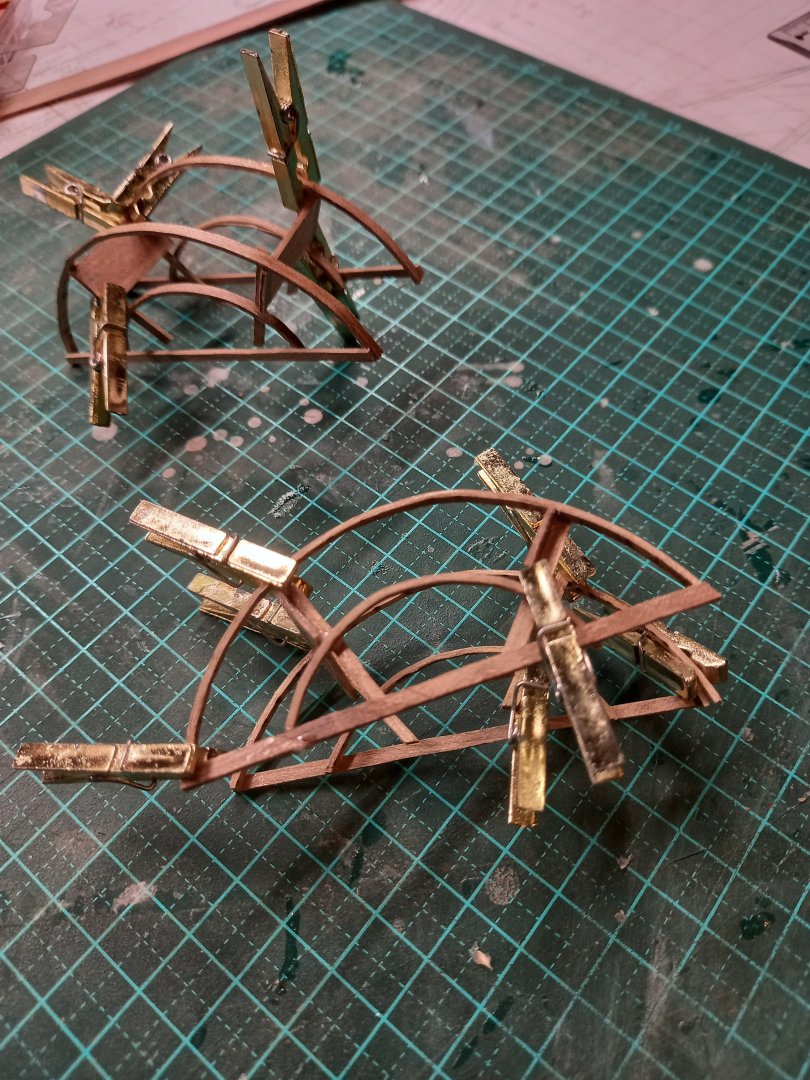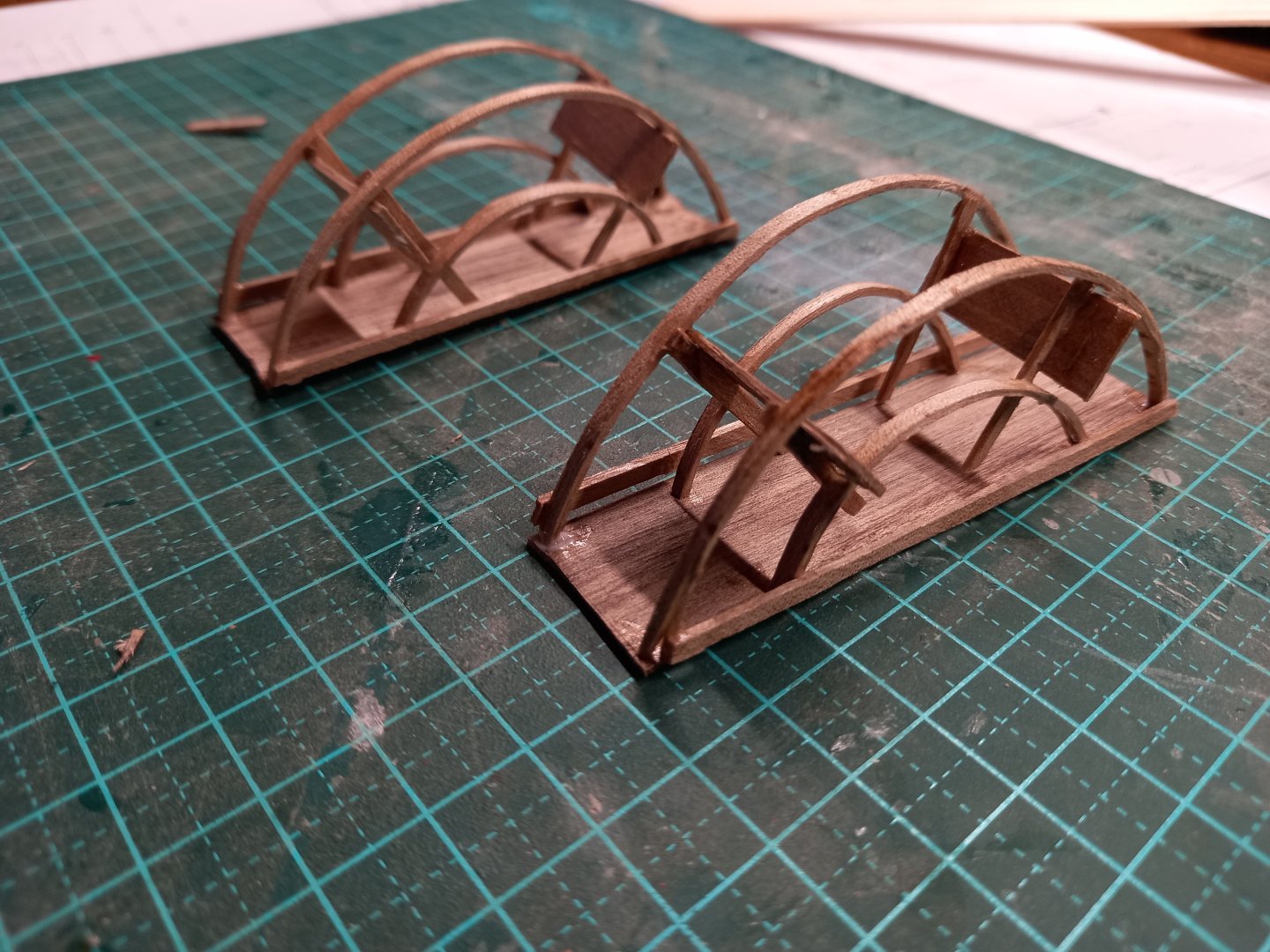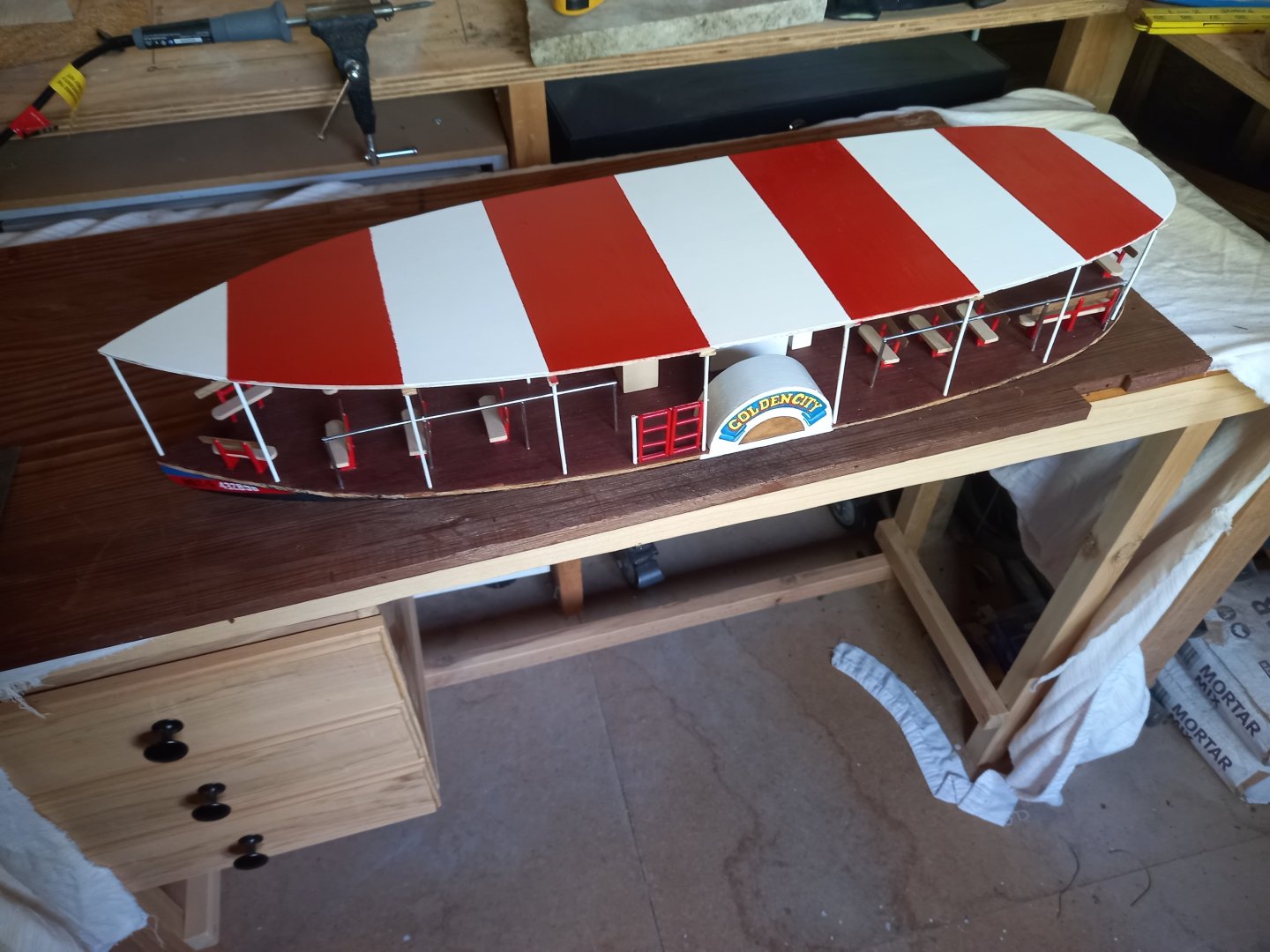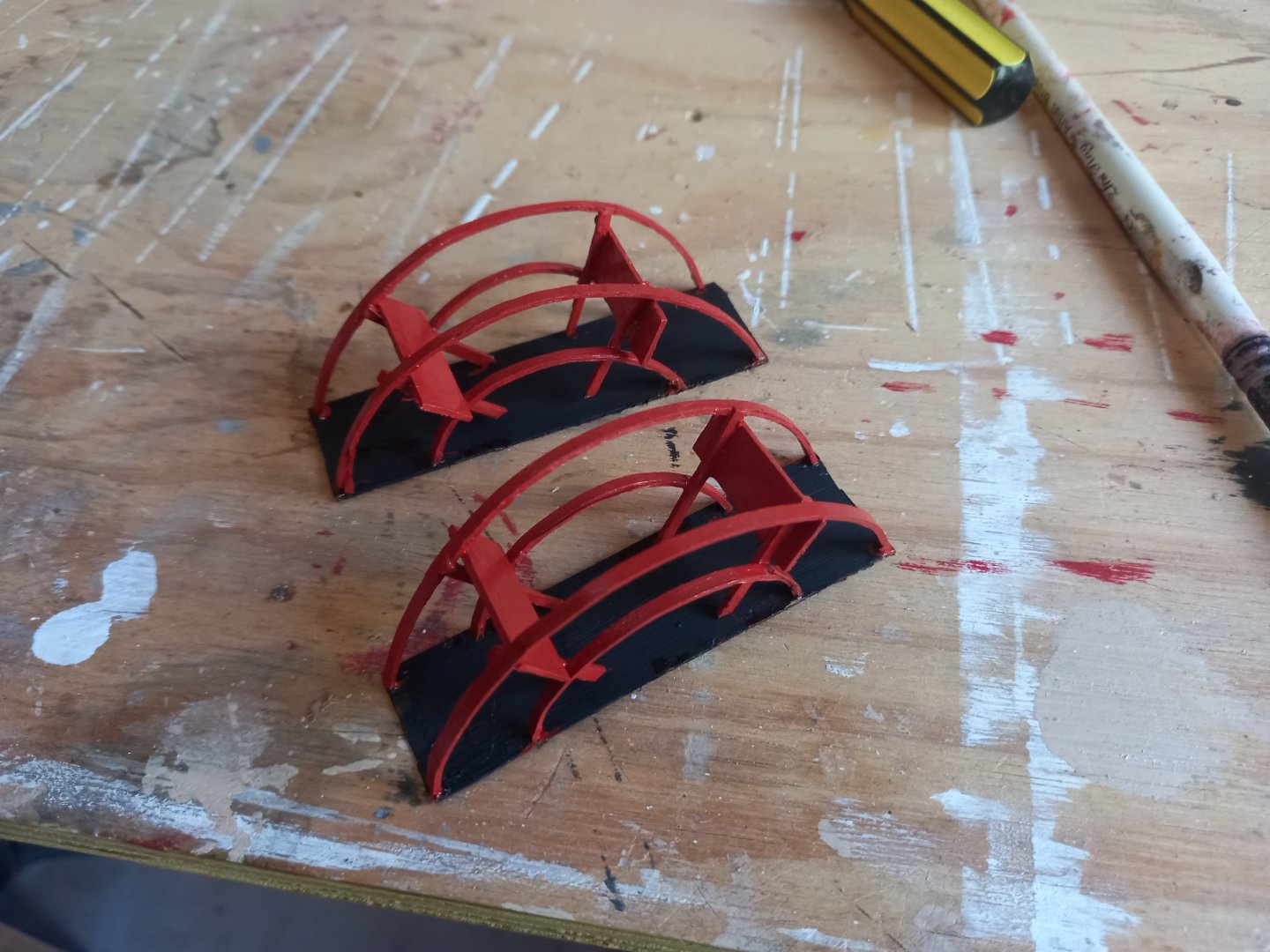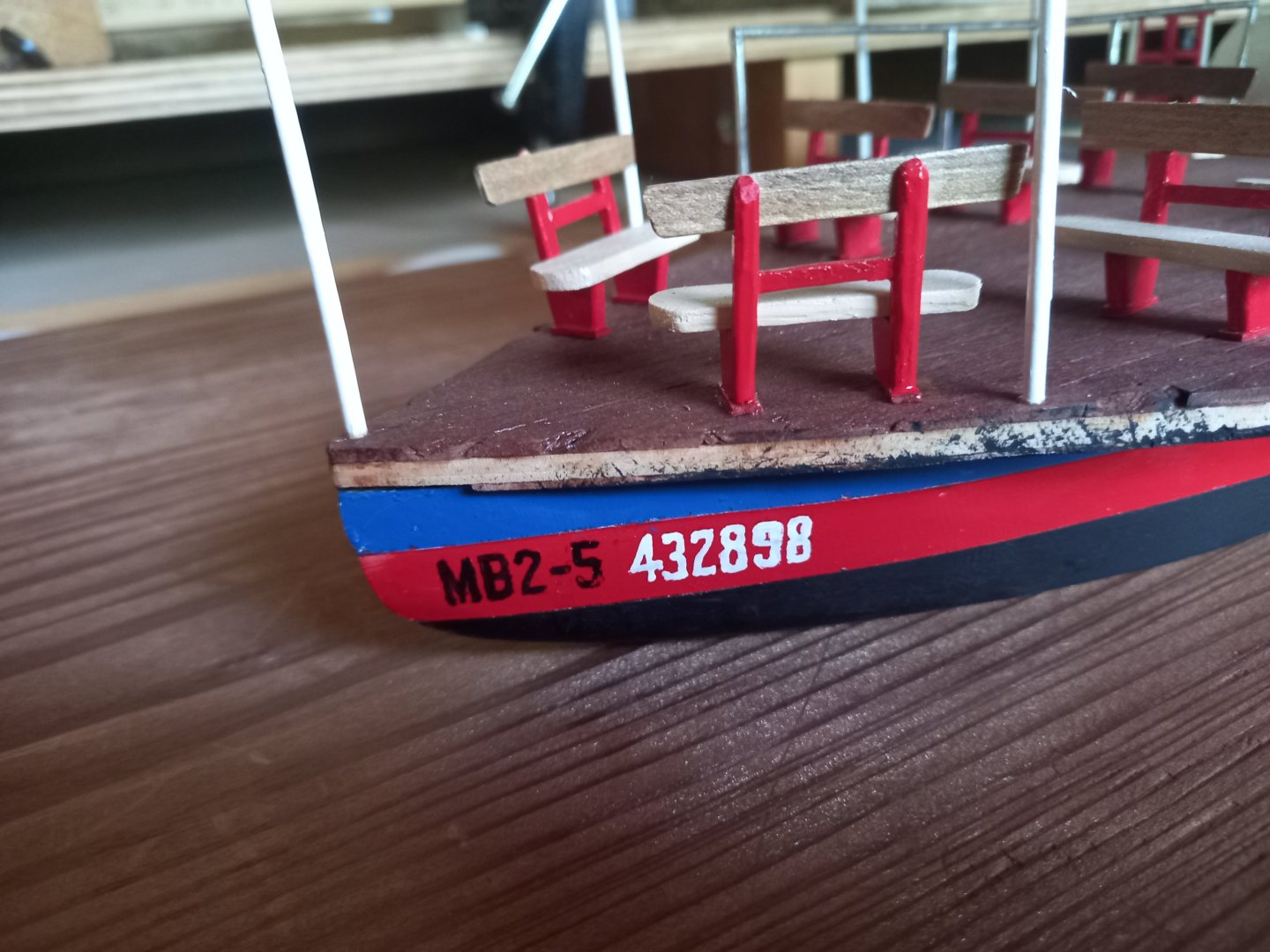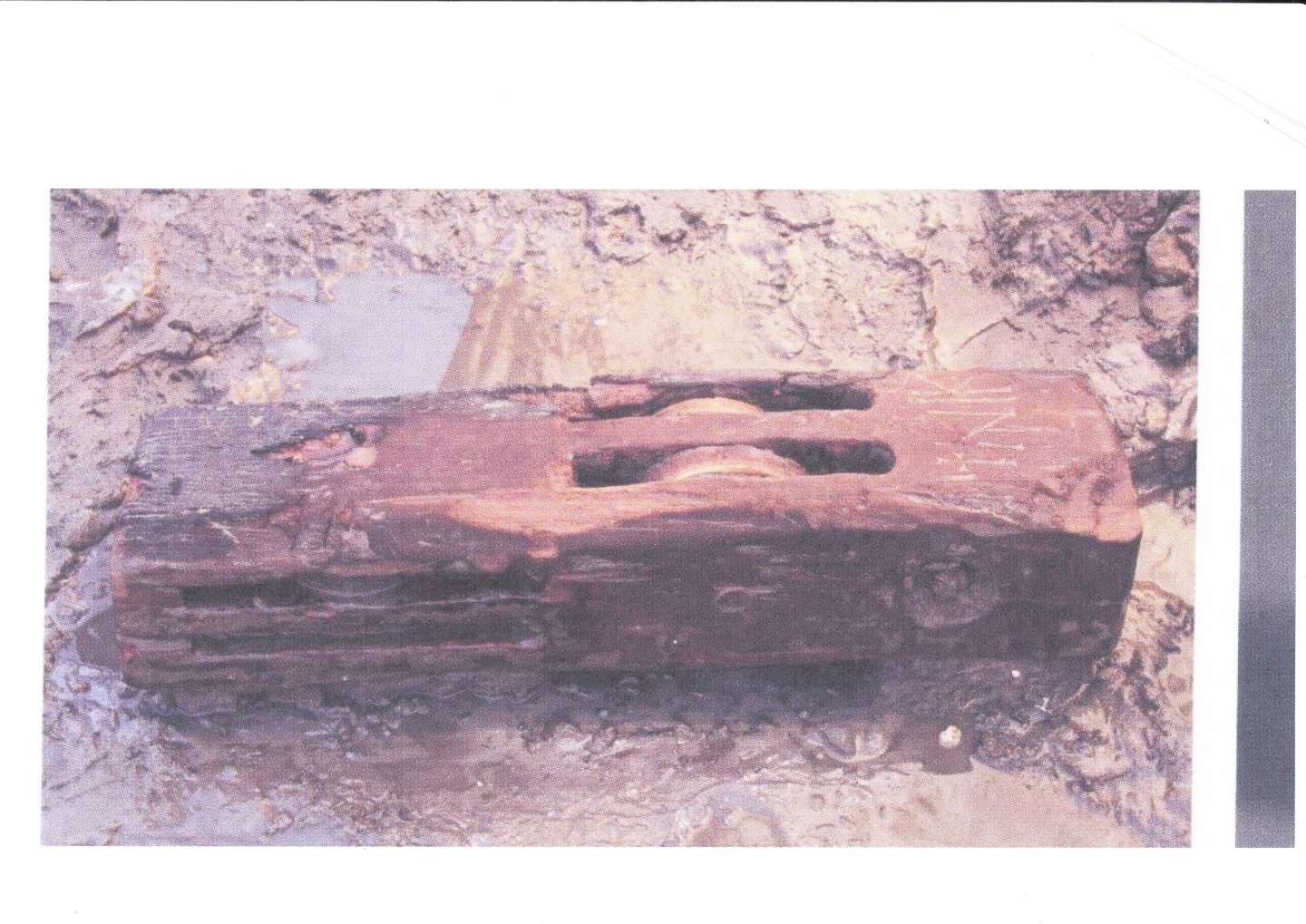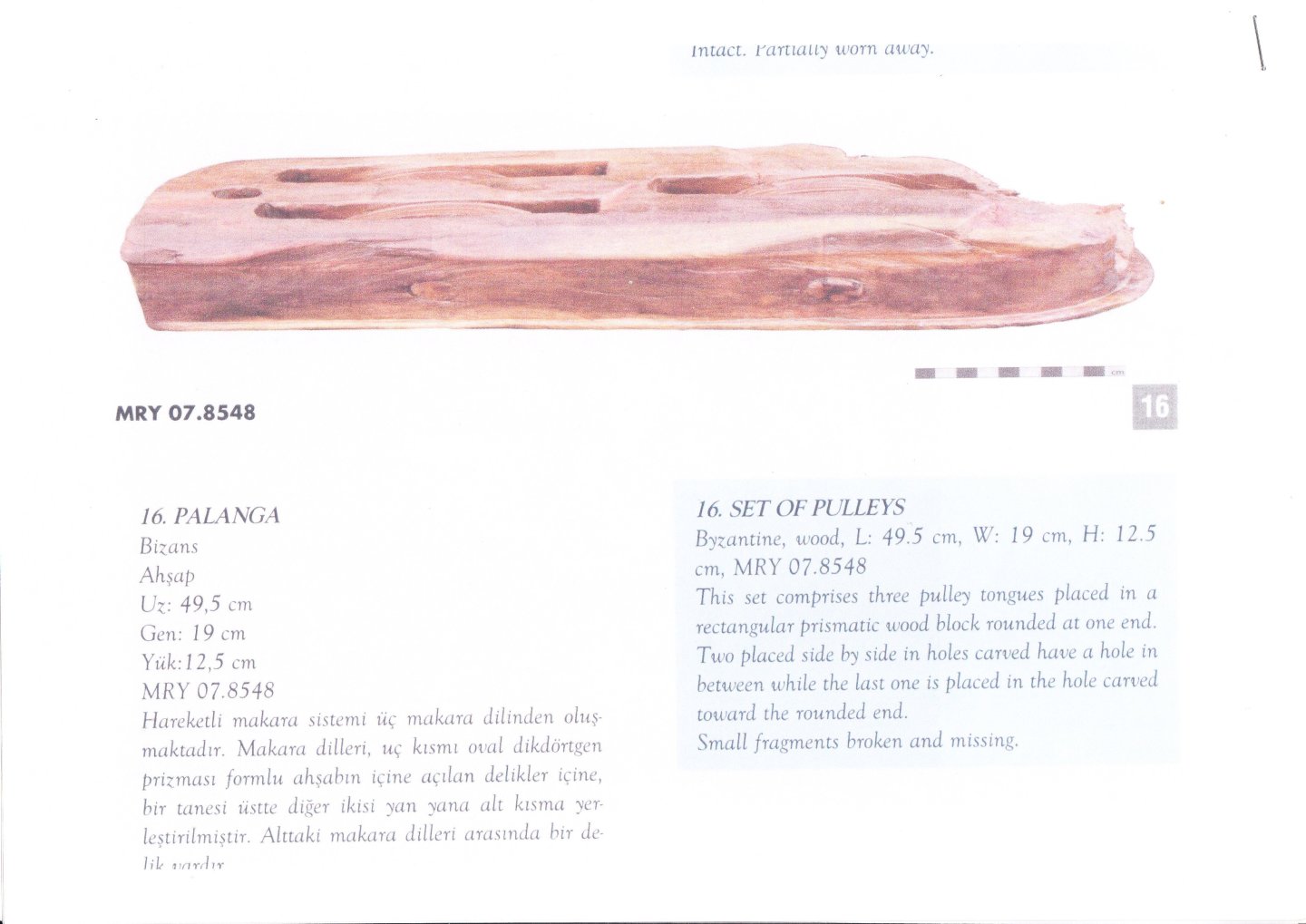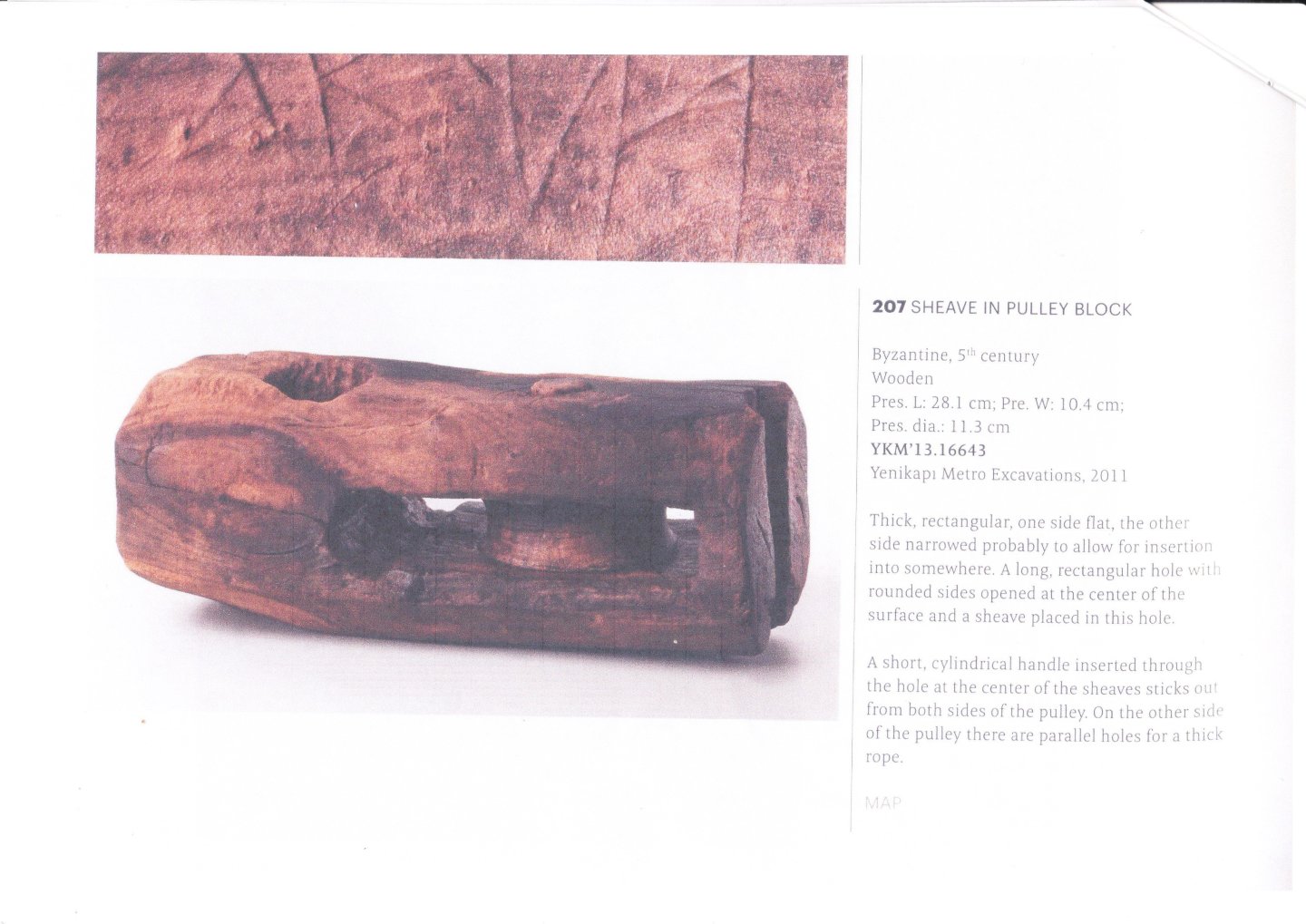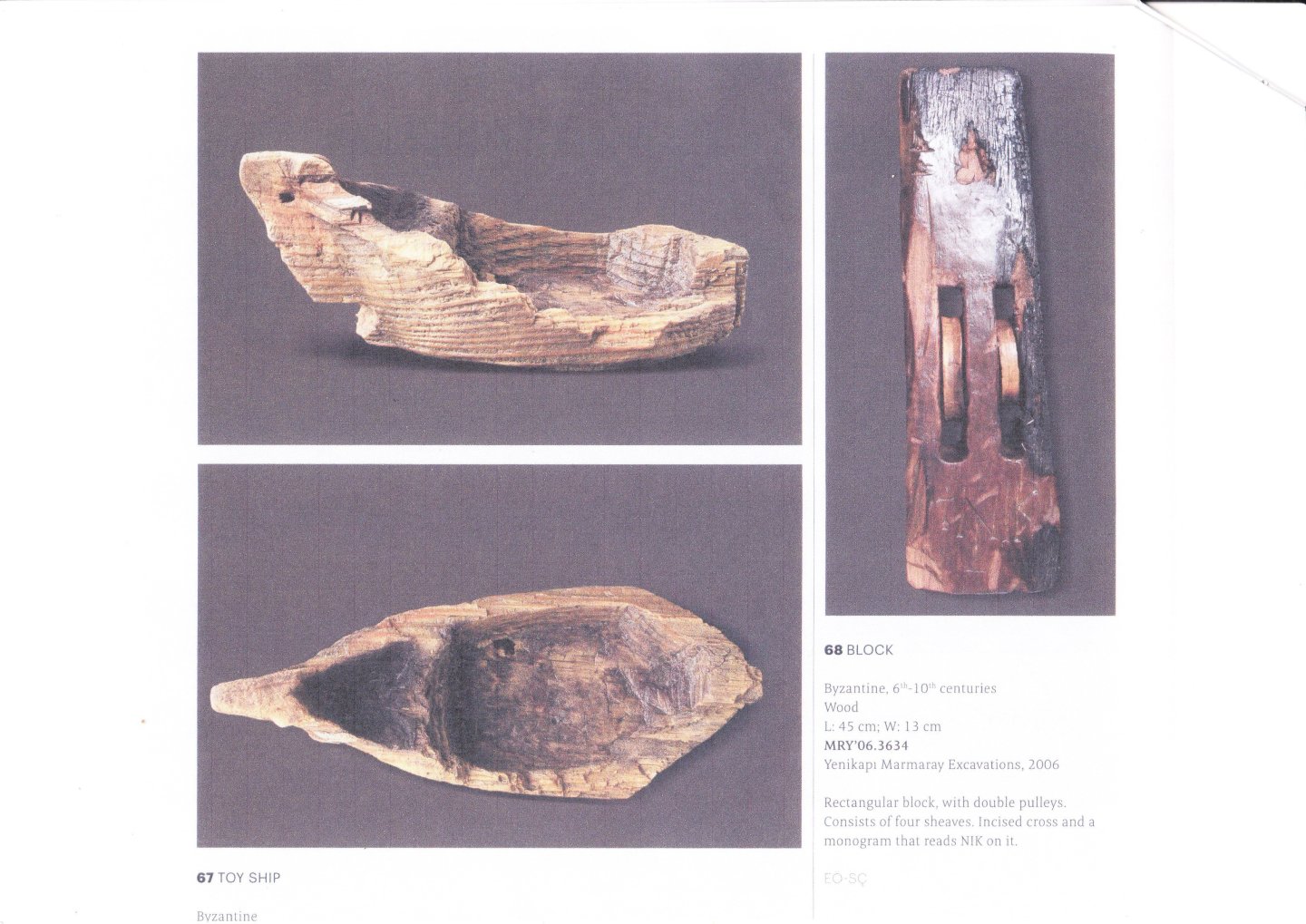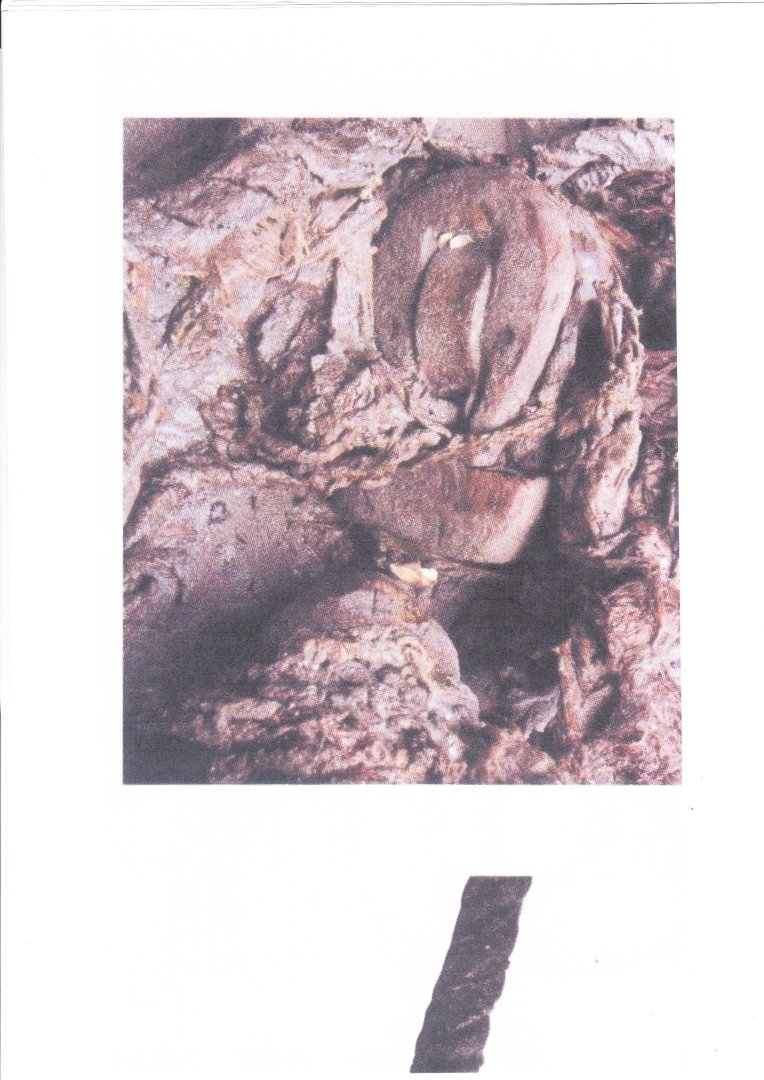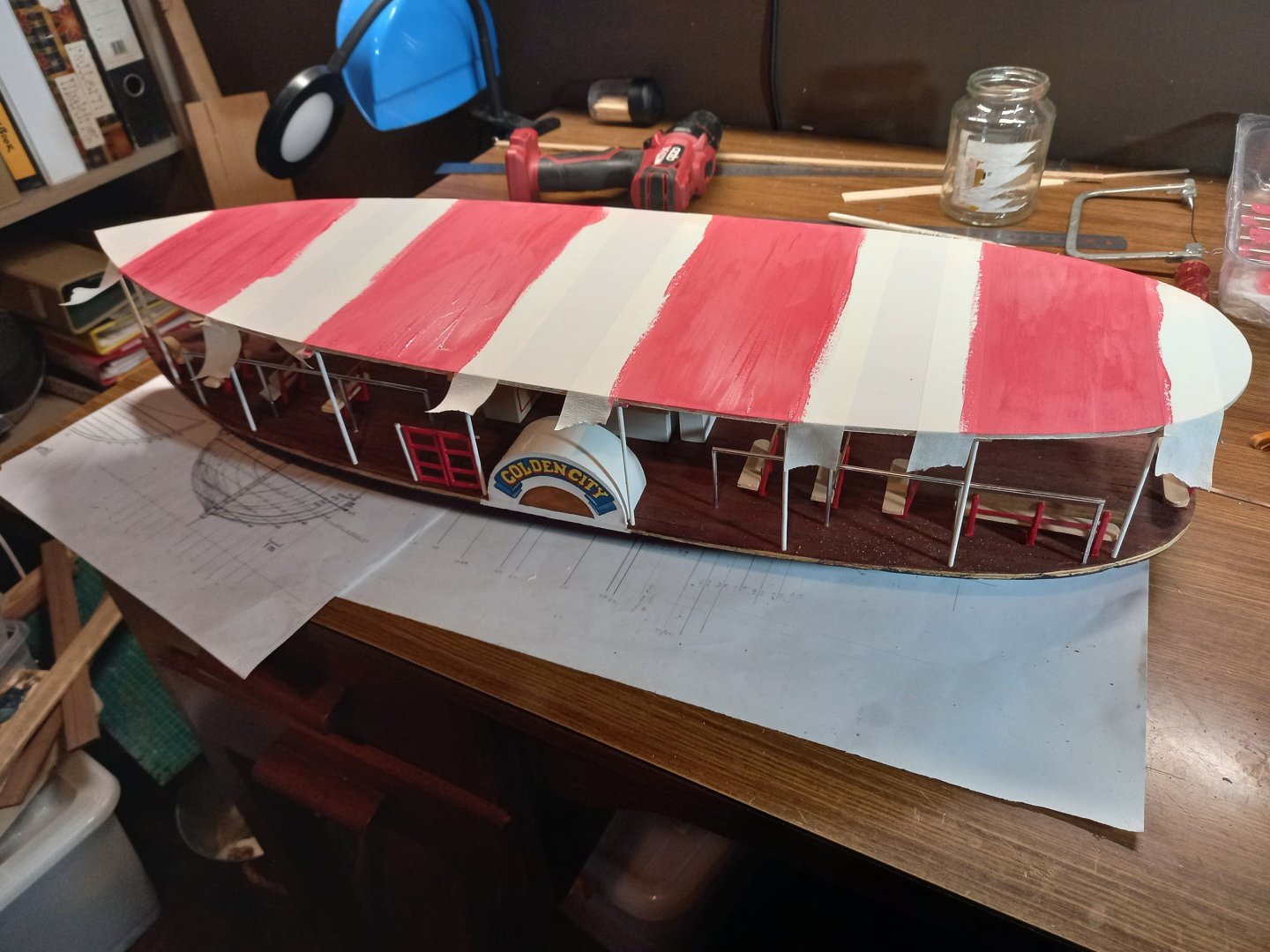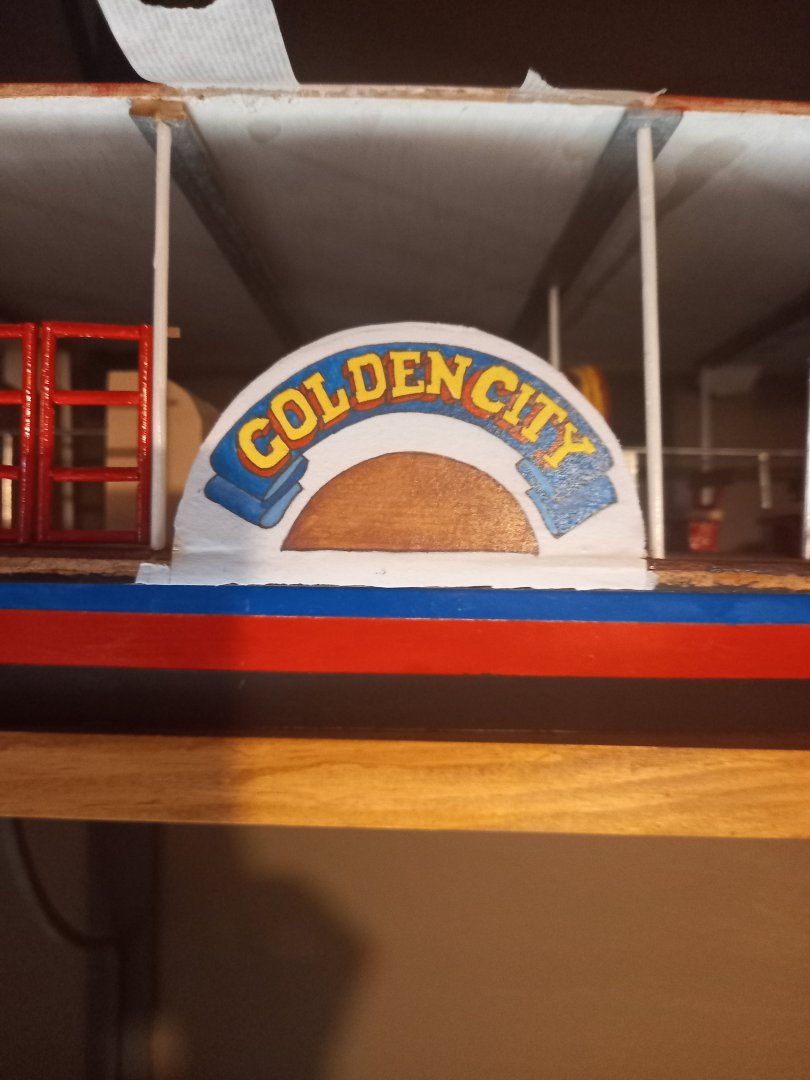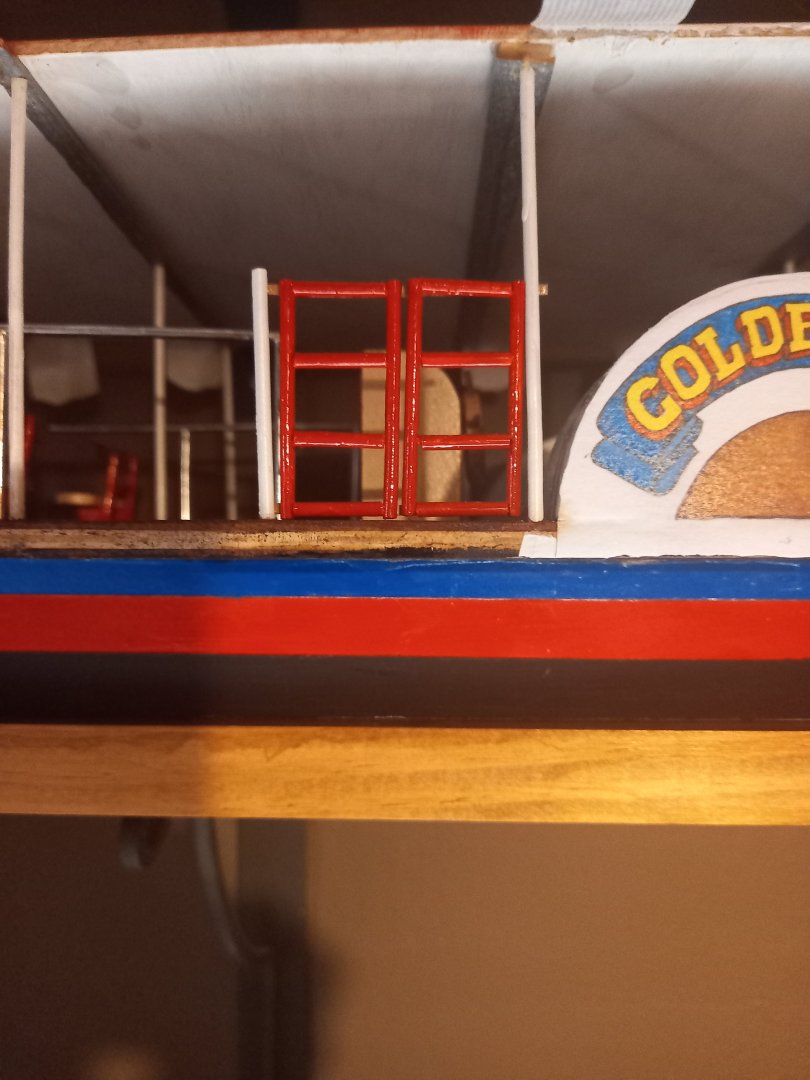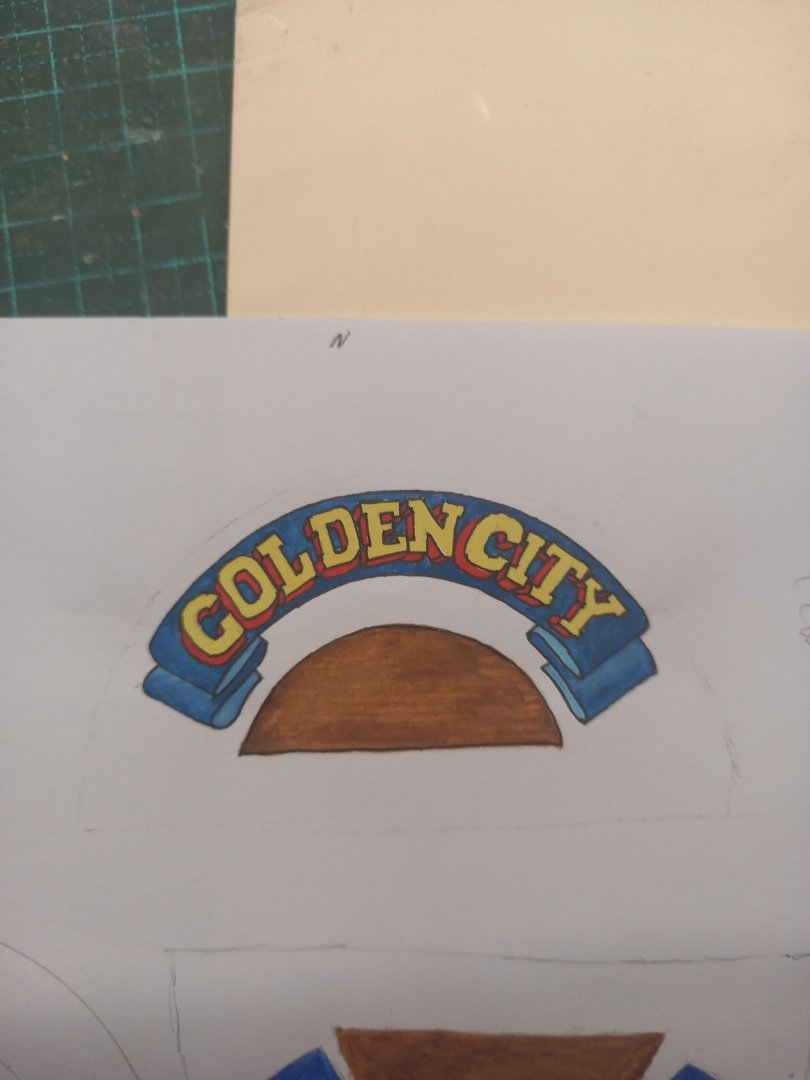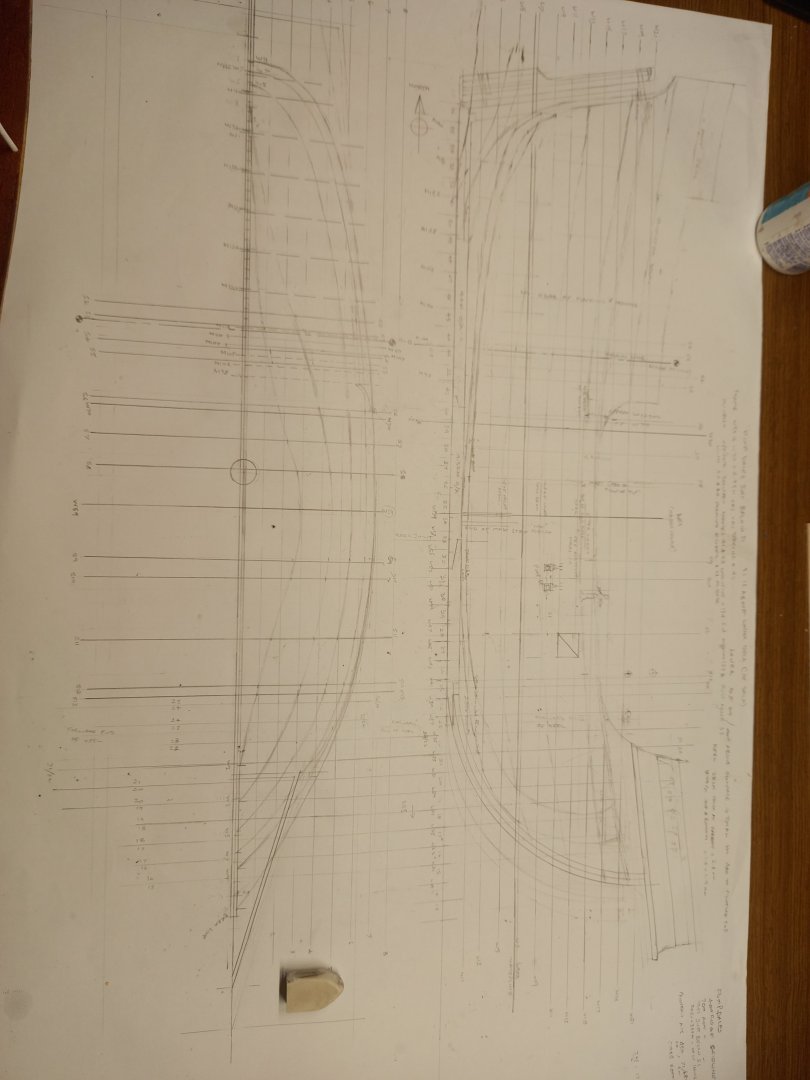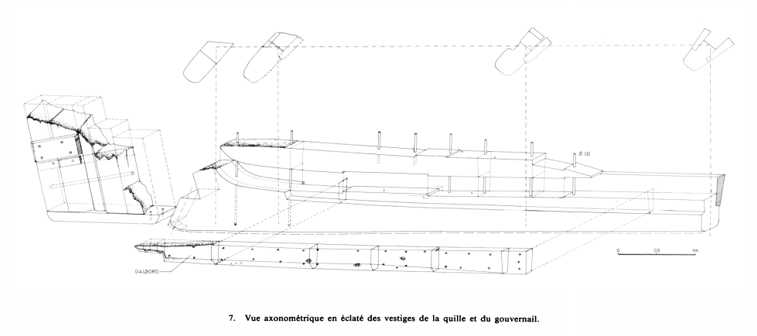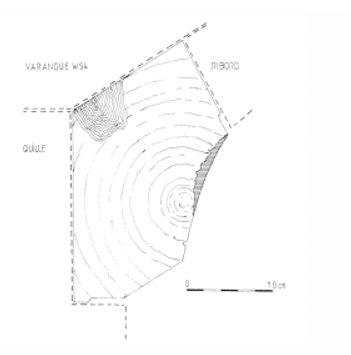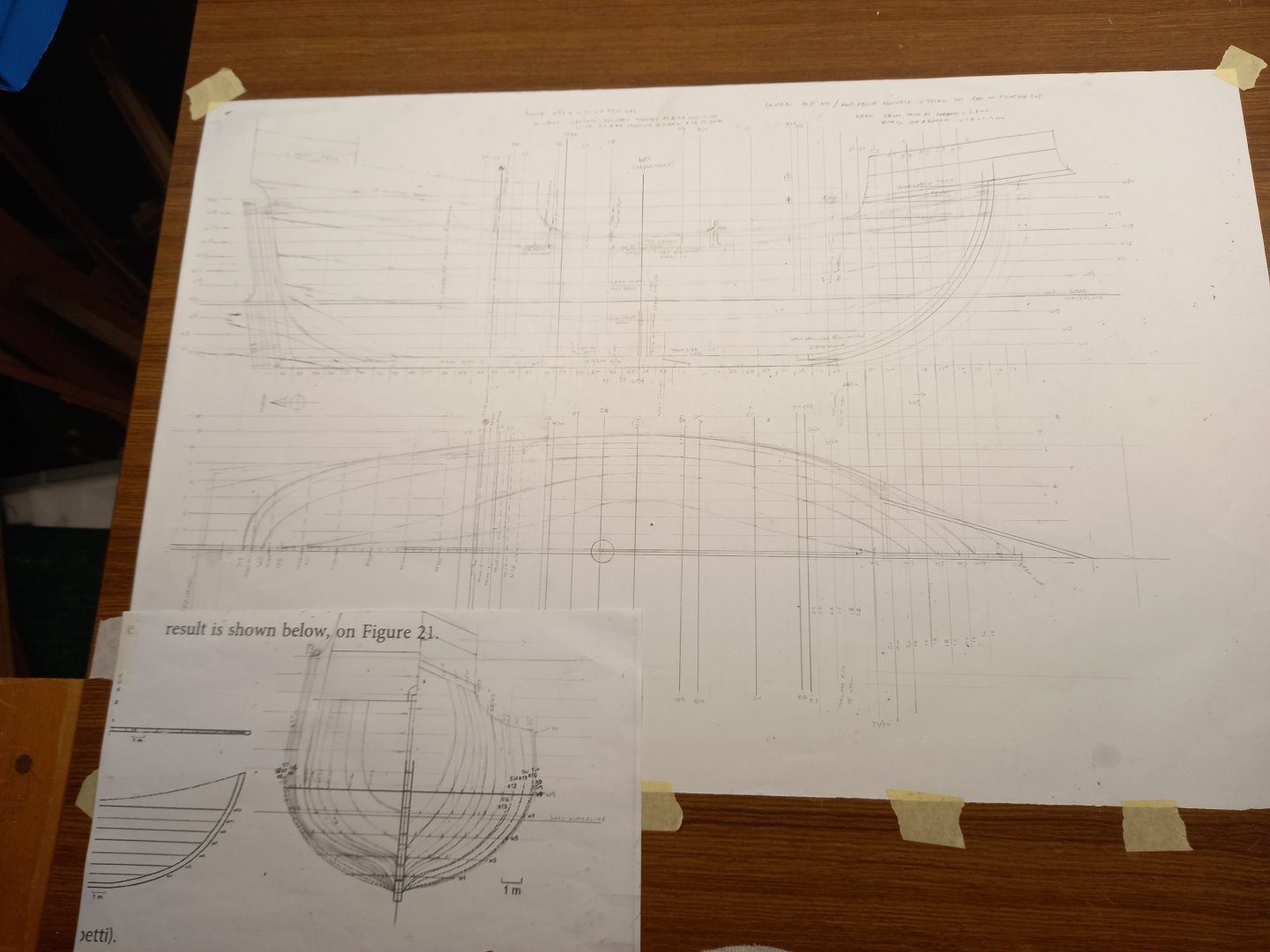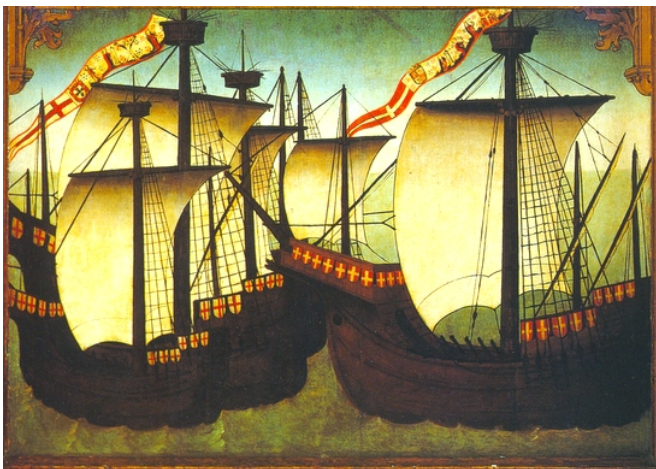-
Posts
7,987 -
Joined
-
Last visited
Content Type
Profiles
Forums
Gallery
Events
Everything posted by Louie da fly
-
I've finished painting the awning. Still have to put the wavy fringe along the edge - not sure how I'm going to do that - paper? Card? Thin aluminium sheet? And here are the paddlewheels, as promised. I used my usual technique to make them - wet the wood and 'roll' it around a (cheap and nasty) soldering iron. Note that I've only made a segment of each, because the rest of the wheel is supposed to be hidden by the housing attached to the hull. Lining up pairs of "wheels" with each other so they would all be nice and square. Didn't really work all that well . . . And trimming them to remove excess. Adding the paddles. Putting the two halves together. It took quite a while to get these acceptable - the tolerances are very strict, the construction is quite frail, and warps and mutates when you look at it, and it was hard to get everything square, particularly the paddles. I eventually put an extra panel at the bottom of each assembly (top, really, as they'll be turned up the other way) to give them rigidity and keep them square. Not perfect, but adequate. And removed the side pieces which had kept everything together up till then. And painted. And here are the registration numbers on the bow, done with a fine watercolour paintbrush. A little wavery, but overall not too shabby considering the difficulties. Steven
- 110 replies
-
- Paddlewheeler
- Ballarat
-
(and 3 more)
Tagged with:
-

Remains of 500 year-old shipwreck: Dated 2019
Louie da fly replied to Allegheny's topic in Nautical/Naval History
Yes. I'm amazed what they can reconstruct sometimes with the scattered remains they are able to recover. Steven -
That's beautiful work, Richard. One small point regarding the blocks - the early ones I'm familiar with (admittedly mediaeval rather than ancient) seem generally to be rectangular rather than round. Some examples: Though there is one with a rounded end: It might be worthwhile to see if you can find surviving examples from your period to check against. Steven
-

Remains of 500 year-old shipwreck: Dated 2019
Louie da fly replied to Allegheny's topic in Nautical/Naval History
Thanks for this information. Every so often another wreck from this period comes to notice that I'd never heard of before. I've had a look at the site you linked, and it's fascinating. I'd love to see the archaeological reports on this one - in particular the kind of information that relates to modelling - the 'lines' of the ship, the equipment found on board, the masts etc. It's a shame nothing else seems to have happened about the Okänt Skepp, but unfortunately these things happen - if it's not Covid then it's lack of funding or some other thing. I'm still hoping there's eventually enough money to see if the forecastle of the Mary Rose can be located. That would be a real find! Steven -
A small update. First, I hadn't mentioned how I'd done the logo on the paddlewheel housing. I had a photo of the vessel side-on, but the definition was pretty bad - certainly not good enough for the model. So I printed the photo out in colour, photocopied it up to the right size, then traced it onto white paper (up against a window in daytime), then re-did it as a new painting. Then colour photocopied it twice, so I had one for each side. And here it is on the model. Pretty happy with that. I've also made the little gates that stop people walking off into the water when she's under way. And I'm working on the painting of the awning roof. Red and white stripes. I've completed the white and just started on the red. First a coat of cheap acrylic - the colour is rather too pink, but it makes a basis and I'll be putting on extra coats with an enamel paint (Humbrol) that is the right colour. Steven
- 110 replies
-
- Paddlewheeler
- Ballarat
-
(and 3 more)
Tagged with:
-
Aaah, planking. So much fun. Your changes look good. And I think you're right to add the gunports to the transom. Not sure what the metal is they made the guns out of, but almost certainly not lead - that stuff's toxic and probably illegal to use in most countries - certainly would be avoided. But there are plenty of metals and alloys which can do the same job. Also IIRC lead shrinks in the mould when it's cast. These ones, for all their faults, don't look like they have done that. Yes, you can probably cast your own using these as 'blanks' to mould from. Steven
-
Oh, I know that. But somehow working out how to do them seems to have been more difficult than doing waterlines. As Pooh says, 'I am a bear of very little brain'. The thing is, working out the shapes of the frames without doing buttock lines ends up with them all the wrong shapes - something I found out doing the Great Harry repair. Steven
-
Still working on the buttock lines. Never done it before and I find myself getting confused as to how to do it. I have two in place now, several more to go - then I have to refer to them to adjust the shapes of the missing frames. A fair bit of adjusting from one thing to another to get everything to work together. And I've now drawn the (single known) gunport on the side view, having tied down its dimensions and location, bot vertically and horizontally. And the same for the pump dales. There were 12 guns found scattered around the ocean floor near the wreck, so presumably she had at least that many, six each side. I now have to work out if it's possible and practical to fit six gunports in the length of the ship. And check against the known planking to see if that contradicts what was found - in other words, are there uninterrupted runs of planking where I want to put gunports? I'm coming to realise that they must not have excavated the whole hull, but dug lateral trenches at intervals to get a variety of cross-sections and leave the rest covered up. So it's quite possible there's no record of uninterrupted runs of planking where I want to check - and even that there may well still be undiscovered gunports in the length of the hull. I suppose I need to check again at the source and see if that's correct. Sigh. Ça marche - pas vite, mais ça marche. (It moves - not fast, but it moves.) Steven
-
Thanks Patrick and Druxey. Patrick, I'd seen the Mary Rose lines before, and in fact they'd been my main influence in drawing the frames near the bow that strange inward curving shape. It still will depend on how that converts into a real-world 3D shape, but I do believe I'm on the right track with it. Druxey, it's still in flux, but I think I've got most of the thing worked out. For example, I just changed the shape of the sweep of the hull at the break of the forecastle - it was too sudden, and looking at my pictures of carracks (particularly the Carpaccio ones, of course) I realised it needed changing. And I'm still thinking about the shape of the aftercastle - there's a certain amount of taper toward the stern, but how much? But I'm pretty happy with it all in general, and I'm just tying down the positions of frames with respect to the grid that was used in measuring the wreck. Basically, the frames seem to be about 500mm apart centre to centre, and using that, plus the known position of the master frame in relation to the grid, I can get a pretty good idea of where all the rest of them are, and relate that to the keel. And I also have a pretty good idea of the location of the mainmast, as the archaeological report notes the location of the fore end of the mast-step assembly. So from that I can locate the main knight and then the capstan. I've figured out where the surviving gunport is (what a joy, finding a gunport!) and its dimensions. She seems to have had 12 guns - welded rods with reinforcing rings. So that's six each side. And I have the locations of the guns in the wreck, so I can at least to a certain degree, get an idea of where they would have fallen from when the wreck disintegrated, and thus where the rest of the gunports might have been. I do enjoy the research, but this is the most mind-melting job I've ever had to do in ship-modelling. It's just a matter of sticking with it until I'm happy that I can't improve on it any further. Steven
-
Yes, carracks were nowhere near as tubby as people seem to believe. This one appears to be more than usually slender. And the garboard was made out of half a tree trunk carved to shape. Near the stern, its quite thin (see the four cross-sections of the keel above the side view), But as it goes forward it changes shape dramatically, to follow the widening of the hull while keeping enough thickness for structural strength. The titles translated: Varangue = floor timber, Quille = keel, Ribord = bottom plank Fascinating stuff. It's like figuring out a jigsaw puzzle. What the French call a Roman policier - a detective story. Steven
-
More research and fiddle; trying to work out what the French text really means, cross-checking things against each other to get everything sorted before I start cutting wood so I don't paint myself into a corner as I've done too many times in the past. I'm sure I won't be completely successful in that, but even that is part of the learning process. So I've now worked up a set of lines that I'm reasonably happy with. Subject to practical application in the real world. Still a bit uncertain about the configuration of the aftercastle and the frame shapes for the bow directly under the forecastle. But whatever, here it is. It doesn't fully agree with the lines shown in the latest academic paper, but that doesn't worry me all that much. I didn't like them. I still haven't worked up the buttock lines, and I suppose I really ought to, to check that the others all work. For me this is a real slog. I have to take frequent breaks and do something else, or my brain melts. But I've just sorted out the thickness of the keel and 4 cross sections of its after part, as well as (I hope) all the lengths of the 4 pieces of timber that make it up - plus I'm pretty happy with the configurations of both stempost and sternpost (neither of which were recovered). Which means I can - if I want - start making sawdust. I suppose I now have to screw up my courage and make a start. I'm using oak for as much of the structure - keel, frames etc - as possible, but I might run out before I'm finished. If so, I'll just have to proceed with another type of timber. Not to worry - it won't be visible anyway. Watch this space. Steven
-

Remains of 500 year-old shipwreck: Dated 2019
Louie da fly replied to Allegheny's topic in Nautical/Naval History
I came across this on the Facebook site Archaeology and Civilisations. Though the wreck is not specified, from the description it appears to refer to the same ship. Among the islands of the Stockholm archipelago, at a depth of 28 meters, in 2017 the wreck of a merchant ship dating back to the 16th century, probably Swedish made, destined for the transport of material was located and documented by the archaeologists of the National Maritime Museum. ferrous and in particular of Osmond iron, of which about thirty barrels have been found. Loads of this type of iron, produced mainly in the Scandinavian area and exported to Germany and Holland in the form of spheres obtained from the refining of crude iron in special furnaces, are known only in two other shipwrecks, always from the waters of the Baltic. The ship, in excellent conservation conditions like most of the wooden wrecks of the area, thanks to the particular conditions of salinity and temperature of the Baltic that protect hulls and superstructures from the destructive action of xylophagous and teredini, still has the mast in the position of navigation, is about 20 meters long and 7.5 wide, and is characterized by elements of naval carpentry halfway between medieval construction techniques and those of the modern age: a precious fossil guides, in short, an age of great transformations , able to tell with a remarkable level of detail the transport of raw and refined metals between Sweden and Finland around the middle of the sixteenth century. Despite the decision to keep the wreck's coordinates secret, however, the looters managed to locate the site, and in the course of repeated dives they stole pottery and significant artifacts protected for five centuries from the cold waters of the Baltic: this is what the underwater archaeologists involved in the study of the wreck, recently returned to explore the hull. "What happened was very sad: it was like tearing pages from a book; now we have the cover left, but we have lost the content forever", Jim Hansson, the archaeologist who has been coordinating operations on the site. The looting apparently went on for several months. By the way, the comment about missing artefacts is very apposite in archaeology. They are often the best means of determining an accurate dating for the wreck - particularly pottery which went through relatively rapid changes of fashion, and of course coins, which usually had the date on them. Having them stolen makes it very difficult. Steven -
Yep. Look at the top right of the page - you'll see a pair of speech bubbles joined together. That's how you start a PM. Type in the addressee's screen name and away you go. Steven
-
Off to a good beginning! One thing I'd recommend is that you see if you can find out how many gunports survive on the wreck and if you can extrapolate from there how many she actually would have had. I think it's pretty well accepted that Anthony Anthony exaggerated the number of guns in his picture. More guns is not necessarily better, if you want to duplicate as well as possible the way she was. But also check the Anthony Roll for the number of guns the text below the picture says Mary Rose has. Yes, McElvogue did definitely make some things up - for example, there was no boat found with the wreck, but he has drawn one. Just be aware of that and use your best judgment as to whether to believe him, and check his book for actual evidence he's based his stuff on. I'm talking from experience - I went with some of his ideas and found to my regret they were speculation rather than evidence-based. And if you don't already have it, I'd recommend R.C. Anderson's The Rigging of Ships in the Days of the Spritsail Topmast for when you get to the rigging. Yes, it relates to ships from a later date - his book starts at 1600 - but it's possible to extrapolate backwards and get a fair idea of what would have been already in use in 1545. And also refer to the two contemporary pictures that show Henry VIII's ships - the Anthony Roll and the painting The Embarkation of Henry VIII at Dover for the Field of the Cloth of Gold - for more details of rigging. For example, the latter one (despite its faults, and it does have them) shows sailors working on the yards without footropes - they were a later invention. And also other contemporary images from around the same time. See in particular my collection of 'Great Carracks' at https://au.pinterest.com/lowe1847/great-carracksnaos/ Interesting that Marsden is also thinking in terms of three decks for forecastle and aftercastle. McElvogue seems to think that's maybe taking it a bit far, but I think it's best to just use your judgment (and cardboard mock-ups) to see what you think. It's all speculation past a certain point, and your guess may be as good as anybody else's. Looking good, mate. Steven
-
Three steps forward, two steps back. I'd seen a mention in the report linked in post #17 above, that the forward end of the keel curved upwards in the last 2.3 metres of its length, but that seemed to contradict another computation in the same paper relating to the rake of the stempost, so I ignored it. Now I discover there's an actual photo of this curved end which means I've had to redraw the front of the keel, start the curve of the stem 2.3 metres aft of where it had been, move the forecastle back by 2.3 metres, you name it. I still can't reconcile the computation of 10.25 metres for the rake of the stem - it makes it look ridiculously sharp. I'm prepared to have the stempost leaning forward somewhat - that's shown in contemporary pictures but not to this extent - though I'm prepared to acknowledge that I may have simply not understood what the author was trying to get at - here's the relevant pic from his own reconstruction (the bow is on the right) and perhaps this isn't meant to be the whole run of the curve - maybe it's meant to get more vertical as it gets higher? Those vertical lines in this pic indicate the surviving frames that they measured, but if you look at this sectional view, you can see that they don't really go very high in relation to what must have been the full height of the hull. Anyhow, I've shifted the stempost back and fiddled with the radius so as to have a stempost leaning forward to somewhere near what I think it should be, but the centre of the arc is much higher than where the author puts it. And then there's the frames. I still haven't been able to reconcile frame numbers with positions on the hull. I think their numbering system starts with floor timbers (# 1 at the forward end and and simply increasing the number value as you proceed aft?) and then keeping those numbers for the corresponding knees and futtocks they connect to - except that they started their excavation at the stern, and didn't get to the bow for several years, so how could that work? Plus they weren't always able to reconcile a particular knee or futtock to the corresponding timbers. It's all a little confusing. At least I have been able to work out where the (assumed) master frame is along the length of the keel, and also I'm pretty sure I have the position of the mainmast tied down. I think I'm going to ignore the frame numbers and just put frames in at regular intervals, making up my own numbers. On the real thing they're about 500mm (a bit over 18 inches) between centres. Which means something like 80 frames. But the frame profiles change in width really gradually. And if I follow the real vessel each frame has to be made from a floor timber, two knees, two first futtocks and two second futtocks. Part of me wants to put in all the frames, each one made from 7 pieces, another part says "nobody will ever see them - why bother?" Retro me Satanas? Oh, and they obviously didn't use the mezza luna technique of framing which I used on the San Marco ship - in which all futtocks have the same radius, they're just further away from the keel as the hull gets wider - these frames all seem to have have different futtock radii. Fun and games, kiddies. I'll think about it some more and see how I feel about it all (sigh). Steven
About us
Modelshipworld - Advancing Ship Modeling through Research
SSL Secured
Your security is important for us so this Website is SSL-Secured
NRG Mailing Address
Nautical Research Guild
237 South Lincoln Street
Westmont IL, 60559-1917
Model Ship World ® and the MSW logo are Registered Trademarks, and belong to the Nautical Research Guild (United States Patent and Trademark Office: No. 6,929,264 & No. 6,929,274, registered Dec. 20, 2022)
Helpful Links
About the NRG
If you enjoy building ship models that are historically accurate as well as beautiful, then The Nautical Research Guild (NRG) is just right for you.
The Guild is a non-profit educational organization whose mission is to “Advance Ship Modeling Through Research”. We provide support to our members in their efforts to raise the quality of their model ships.
The Nautical Research Guild has published our world-renowned quarterly magazine, The Nautical Research Journal, since 1955. The pages of the Journal are full of articles by accomplished ship modelers who show you how they create those exquisite details on their models, and by maritime historians who show you the correct details to build. The Journal is available in both print and digital editions. Go to the NRG web site (www.thenrg.org) to download a complimentary digital copy of the Journal. The NRG also publishes plan sets, books and compilations of back issues of the Journal and the former Ships in Scale and Model Ship Builder magazines.


